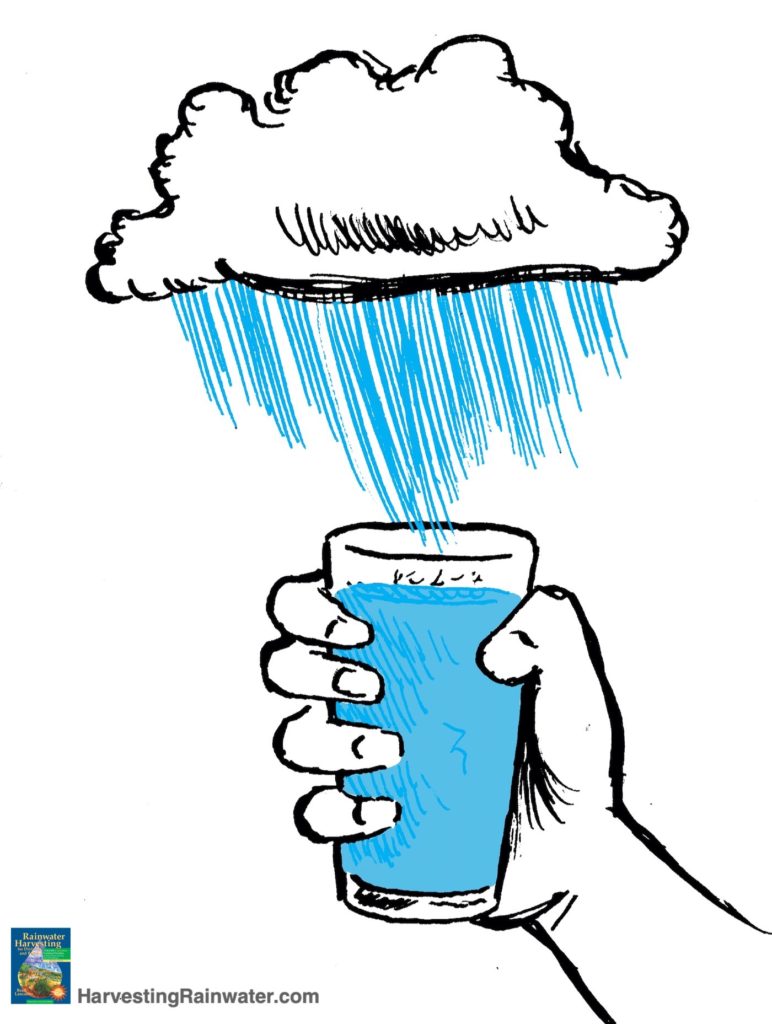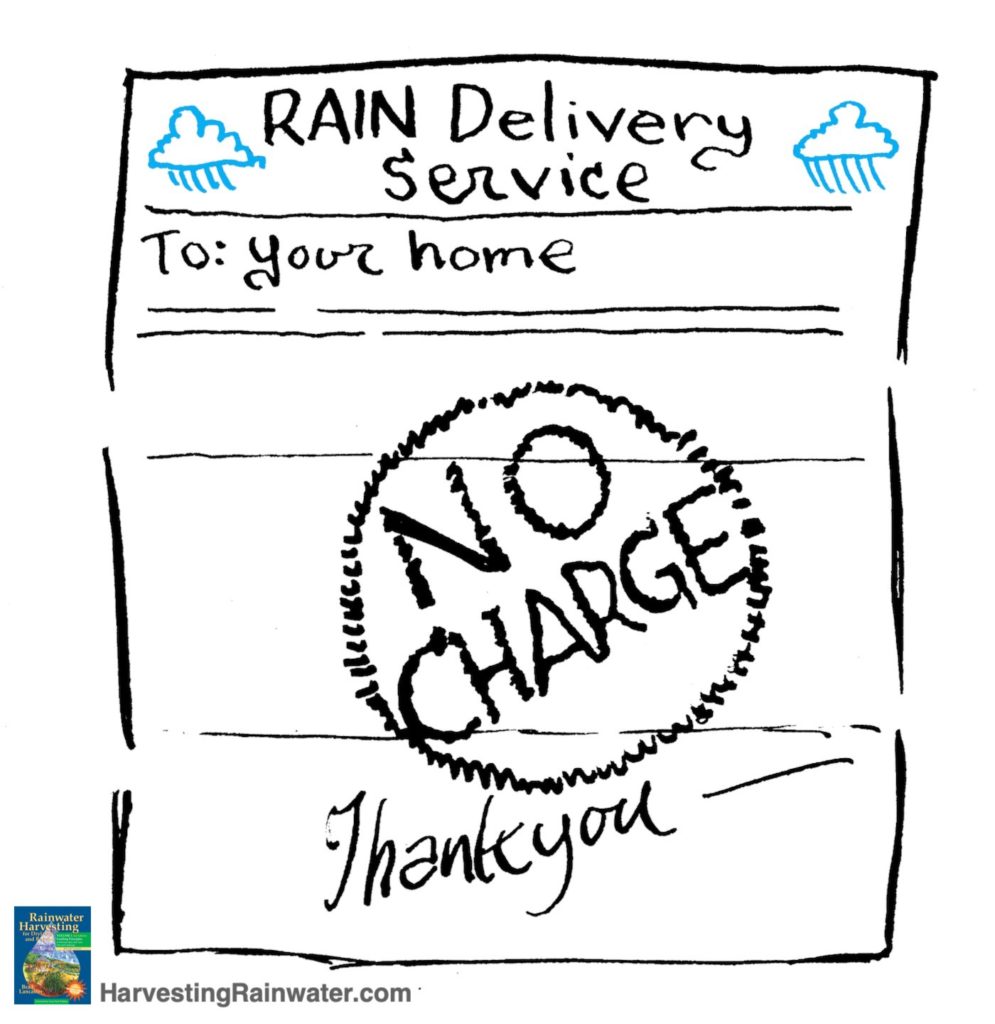Rainwater Harvesting
Rainwater Harvesting is the practice of embracing/capturing precipitation and sharing/using it as close as possible to where it falls. The process mimics intact and healthy ecosystems, which naturally infiltrate rainwater into the soil and cycle it through myriad life forms. Instead of sealing and dehydrating the landscape with impervious pavement, convex shapes, or removal of perennial vegetation—all practices which drain the gift of rainwater away, as most modern cities, suburbs, farms, and home landscapes do—harvesting accepts rain and allows it to follow its natural path to productivity.
Precipitation (rain, hail, sleet, and snowfall) is the primary source of fresh water within our planet’s hydrologic cycle. This precipitation, or “rain,” supplies all secondary sources of water including groundwater and surface water in creeks, rivers, and lakes. If consistently pumped or drained faster than they are replenished, these secondary sources eventually cease to exist. Though these secondary water sources can rebound if their rate of natural replenishment from precipitation is able to again exceed the rate at which they are pumped/extracted or drained.
Precipitation is naturally distilled through evaporation prior to cloud formation and thus is one of our purest sources of water. Rainwater is known as “sweet water” around the world because it lacks the salts found in ground and surface waters.

Also know as sweet water due to its lack of salts.
Reproduced with permission from Rainwater Harvesting for Drylands and Beyond, Volume 1, 3rd Edition. Illustration by Joe Marshall
Rain is considered soft due to the lack of calcium carbonate or magnesium in solution, and is excellent for cooking, washing, and saving energy. Much of our ground and surface water is hard due to the calcium and magnesium compounds that dissolve as water runs through or over soil. These compounds deposit on or in cookware, pipes, and water heaters forming white “scale” that inhibits heat conductionand shortens pipe and appliance life. Using rainwater instead saves energy and maintenance costs, and can prolong the life of water heaters and pipes. Rainwater use also reduces detergent and soap requirements, and eliminates soap scum, hardness deposits, and the need for a water softener (sometimes required with well water systems), besides being a natural hair conditioner.
Rainwater is a natural fertilizer. According to cooperative extension agent John Begeman, rain contains sulfur—important in the formation of plant amino acids, and it contains beneficial microorganisms and mineral nutrients collected from dust in the air— important for plant growth. Rainwater also contains nitrogen, which triggers the greening of plants. During storms, lightning strikes enable atmospheric nitrogen to combine with hydrogen or oxygen to form ammonium and nitrate, two forms of nitrogen that go into solution in atmospheric moisture and can be used by plants.
Rainwater has the lowest salt content of natural fresh water sources so it is a superior water source for plants. Calcium, magnesium, potassium, and sodium salts are abundant in the earth’s crust. Soils with high salt concentrations inhibitplant growth by reducing vegetation’s ability to take up water and conduct photosynthesis. Soils high in sodium have a tendency to disperse—or lose their structure—resulting in poor water infiltration, and soil crusting, which restricts root penetration and impedes seedling emergence. As David Cleveland and Daniela Soleri write in Food From Dryland Gardens, “Salty soils occur naturally in arid areas where not enough rain falls to wash soluble salts down and out of the root zone. Irrigation [with surface or groundwater] makes the situation worse, since surface water and groundwater contain more salt than rainwater. Salt tends to build up in the soil as water is continually added through irrigation.”As long as the soil drains and enough rainwater is applied, rainwater can dilute these salts and flush them out of the root zone.
Rainwater comes to us free of charge. It falls from the sky and we don’t pay to pump it nor do we pay a utility company to deliver it. Yet, current management of household and community water resources does not reflect the true value of rain. Rather than treating it as our primary renew- able source of fresh water we typically treat rainwateras a nuisance, diverting it to the storm drain, drainage ditch, or pollutant-laden street. In its place we invest vast resources acquiring lower-quality, secondary sources of ground and surface water. Such contemporary water management contrasts sharply with many thousand-year old rainwater-harvesting traditions.

Reproduced with permission from Rainwater Harvesting for Drylands and Beyond, Volume 1, 3rd Edition. Illustration by Joe Marshall
As rainwater (precipitation) is the mother of all waters, and typically the water of highest quality, this website and its sister books promote water-harvesting systems that first and foremost harvest the rain, but which are also set up to harvest all other free, on-site waters.
For more on these methods/strategies:
- Start with the water harvesting page,
- and…
See the new, full-color, revised editions of Brad’s award-winning books
– available a deep discount, direct from Brad:


